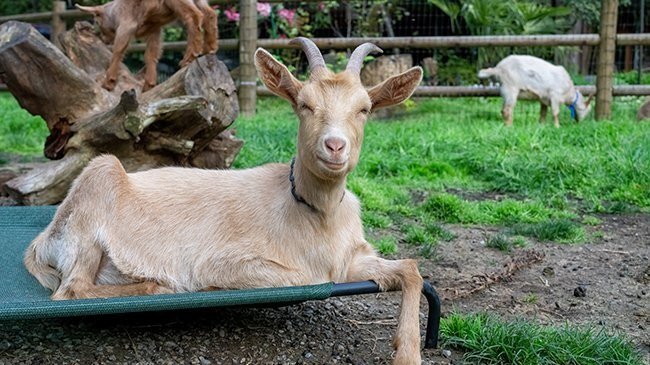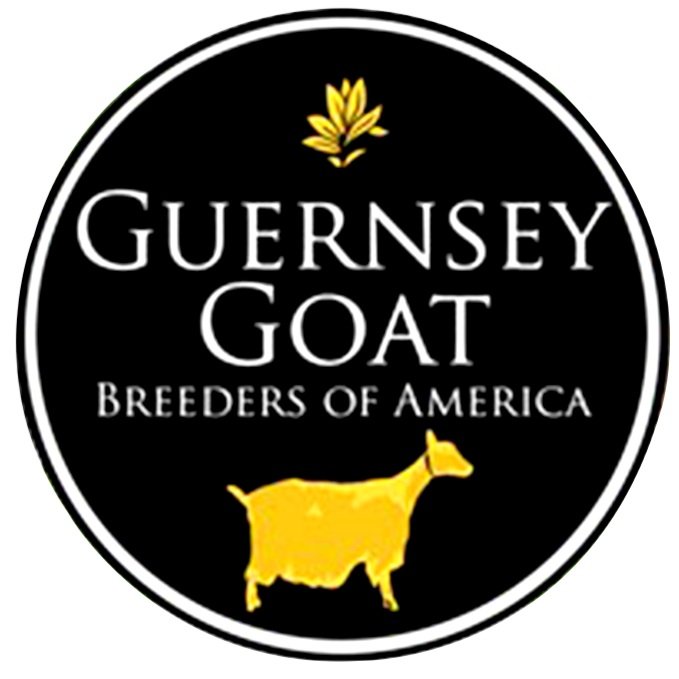
ABOUT GUERNSEY GOATS
Those wonderful ears!
DESCRIPTION/BREED STANDARD
APPEARANCE: The ears are erect and often set slightly lower than Swiss breeds and carried horizontally, or forward in what is termed the “bonnet” position when viewed in profile. Ear tips can be slightly upturned. The ears must not be pendulous. The nose should be either straight or dished. Hair may be short or long and flowing or a combination of both. A long curtain, skirt, and/or dorsal fringe of body hair are desirable, although not required to meet standard.
COLORING: The Guernsey is a golden color, in all shades ranging from very pale flaxen cream to deep russet or bronze. Full or partial roaning; white face; star/blaze are acceptable. White patches are acceptable only for ADGA. The golden body color should be dominant, with no preference shown to any shade or pattern. Crossbred offspring readily inherit the golden coat color, and not all golden goats are necessarily Guernsey. Skin color must display a gold tone, ranging from peachy- flesh to orange-gold in one or more of these places; muzzle, ears, eyes, under tail, mammary or scrotum. Swiss facial stripes and/or rump marking; black markings or spots over 1-1/2 inches are not allowed.
SIZE: The Guernsey is overall medium in size, and the smallest of the standard sized dairy goat breeds. Females are a minimum 26”/120 lbs, and males are a minimum 28”/150 lbs.
THE PERFECT FAMILY GOAT
The Guernsey character is docile and gracious, and they are ideal for homesteading, cottage industry dairy production, and 4-H. They are a wonderful way to introduce youth to livestock, and will quickly endear themselves to the whole family.
PRODUCTION
The Guernsey is an efficient producer of high quality milk for its size, making the breed desirable in a commercial or homestead dairy.
Udders are continuously being improved with breeding up, there are a selection of photos in the homepage gallery.
Although milk yield is less than other dairy goats, food intake is lower and conversion rate high, so they are an economical breed. The milk yields larger cheese weight per volume than average, and known to be exceptionally sweet and creamy. Milking trials in England with 272 individuals (mostly Golden Guernsey) recorded an average 24-hour yield of 3.16 kg at 3.72% butterfat and 2.81% protein. Producers in the US see anywhere from …to be updated!
FAULTS
MODERATE:
Mature does less than
Minimum height (26 in / 66 cm) Minimum weight (120 lbs / 54.54 kg)
Mature bucks less than
Minimum height (28 in / 71 cm) Minimum weight (150 lbs / 68.18 kg)
MODERATE TO SERIOUS: (depending upon degree)
Roman nose
VERY SERIOUS DEFECTS:
Black hairs in the coat
Dominantly white coat on mature does.
No gold tone to skin found on muzzle, ears, eyes, under tail, mammary or scrotum.
DISQUALIFICATIONS:
No gold tone to skin
Swiss facial stripes and/or rump marking (as on Toggenburg or Oberhasli breeds)
Black markings or spots in the hair over 1-1/2 (3.8 cm) in any direction
Pendulous ears, LaMancha type ears
All white coat on mature does, all white or dominantly white coat on bucks
Golden Guernseys are small, fine boned, with a slender neck lacking wattles. British and American Guernseys are frequently larger and heavier boned. For more information on the difference between the Golden Guernsey, British Guernsey, and American Guernsey, see the breeding up page.



